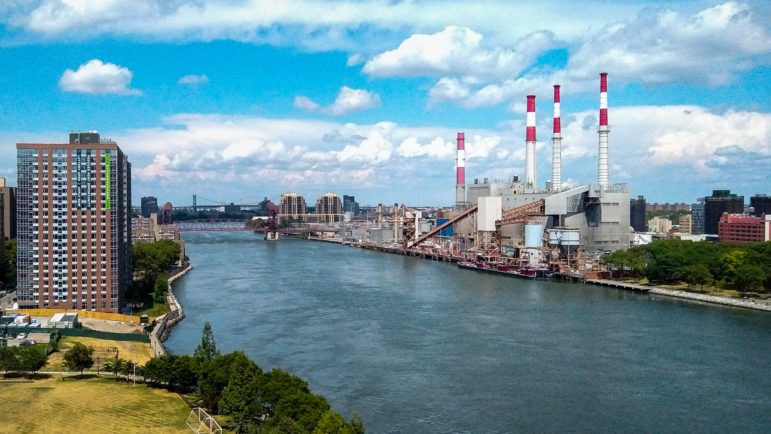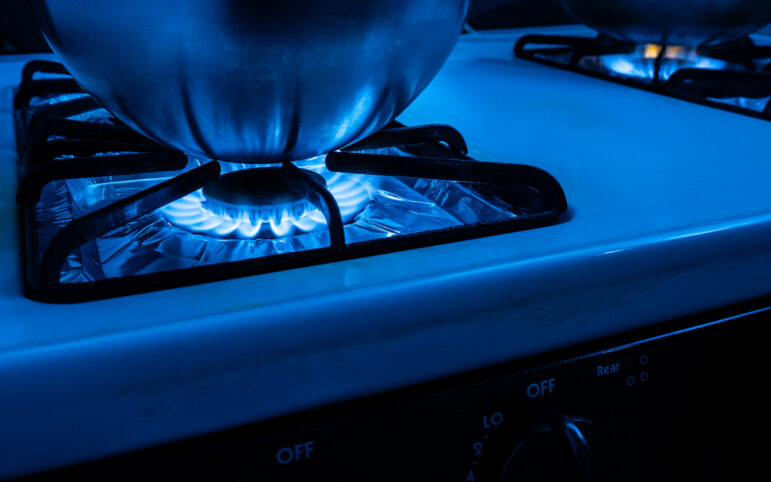Some groups have expressed concerns about the impact one project will have on Indigenous communities, and some want assurances that the state’s shift to clean energy will lead to a shutdown of fossil fuel-powered plants in the city’s most vulnerable areas.

Adi Talwar
One of the projects will run high voltage transmission lines 333 miles underground or underwater from the Canadian border, and eventually terminate at a converter station at the northern end of Astoria, Queens.Updated: April 22
Two projects to boost renewable energy in New York and put the state on track to advance its climate initiative got the green light Thursday afternoon following a vote by the New York Public Service Commission. Together they will bring enough solar-, wind- and hydro-powered energy to reduce the state’s reliance on fossil fuels by half, via two power superhighways from Delaware County and Canada, according to the governor’s office.
The companies involved promise green jobs and investments in aquatic and environmental justice projects. But not all are celebrating. Some groups have expressed concerns about the impact one project will have on Indigenous communities, and some want assurances that the state’s shift to clean energy will lead to a shutdown of fossil fuel-powered plants in the city’s most vulnerable areas.
Clean Path New York, a joint project by New York Power Authority, EnergyRe and Invenergy, promises to deliver more than 7.5 million megawatt hours of solar and wind energy into the city.
It will next be subject to a permitting process, which will assess environmental impacts of the siting, design, construction and operation, according to a company executive. If the permits are approved, Clean Path NY will begin operation in 2027.
The Champlain Hudson Power Express project, which was also approved this week, will bring 1,250 megawatts of hydropower from Quebec, Canada. That project, by Hydro-Quebec and Blackstone-owned Transmission Developers, has already received all necessary permits, including a Certificate of Environmental Compatibility and Public Need, according to a company spokesperson. It will begin construction this year and is set to be in operation by 2025.
Combined, the projects are estimated to reduce greenhouse gas emissions by the equivalent of taking 1 million cars off the road, according to the state.
“New York continues to lead the nation with innovative green energy initiatives and has been an example to the rest of the world how to confront the perils of climate change, the existential threat of our time,” Gov. Kathy Hochul said in a press release announcing approval of the projects, which followed a lengthy Request for Proposals process and public comment period.
The projects both generally earned the support of environmental and labor groups, who lauded their potential to reduce New York’s reliance on fossil fuels in line with the goals set by the Climate Leadership and Community Protection Act, while creating green union jobs.
The groups behind the plans have also committed to funding programs that benefit communities most hard hit by the effects of climate change. Clean Path NY has said it would invest $70 million in environmental justice programs, and the Champlain Hudson Power Express project has established a $117 million trust fund to be administered by the Hudson River Foundation over three decades for environmental and advocacy projects related to aquatic health.
But others take issue with certain elements of the Champlain Hudson project, particularly the environmental impact it may have on Indigenous land due to the dams associated with hydropower.
“Virtually every mega dam in what’s currently known as Canada is within 100 kilometers of an Indigenous community,” said Amy Norman, an Inuk Labrador Land Protector in a meeting protesting the project before the vote. “So no matter where this hydropower is coming from, it is disproportionately impacting Indigenous people, it’s harming our ways of life, it’s harming our cultures.”
READ MORE: New York’s Hydropower Plan Stirs Concerns Over Impact on Waterways
Last spring, five First Nations leaders penned a letter to former Deputy Mayor Dean Fuleihan stating opposition to the project. Riverkeeper has also publicly opposed the plan, despite previously speaking in support of it.
“Our opposition to the CHPE project has become more steadfast as the environmental justice impacts of Canadian dams become ever more apparent,” said Richard Webster, Riverkeeper’s legal director.
The Champlain Hudson team acknowledges that its installations are “near or on land that is subject to Indigenous land claims” but says that it has signed agreements with Indigenous communities and nations promising compensation, revenue streams and jobs.
“Both HQ and TDI have a strong commitment to equity and social justice in development of the CHPE project, and this extends to the only First Nations community impacted by the Québec portion of the transmission line, the Mohawk community of Kahnawà:ke,” Gary Sutherland, of Hydro-Quebec said in a statement to City Limits.
One representative with Grand Riverkeeper Labrador in Canada told City Limits those promises amount to “a bribe, basically.”
On April 21, the Mohawk Council of Kahnawà:ke released a statement disparaging the criticism of the project. “The MCK would not have participated in this project, unless it fully aligned with Kahnawà:ke’s environmental values,” wrote Ohén:ton Í:iente ne Ratitsénhaienhs (Grand Chief) Kahsennenhawe Sky-Deer. (Full the full statement here.)
When asked about the environmental impact of the projects, a NYSERDA representative stated that “environmental issues will certainly be addressed during the permitting and construction phase for both projects to ensure maximum efficiency and minimal project and environmental disruption.”
The Clean Path project has generally garnered support from Riverkeeper and other environmental groups, after concern about the proposed placement of a converter station was addressed by the company last summer. But some community organizers have asked New York Power Authority, one of the partners of the project, to also commit to closing its peaker plants, which run on fracked gas and are heavy emitters of pollution.
A representative with the state-run company told City Limits it was working with the PEAK Coalition, a group of five environmental justice organizations, to conduct a study into how the plants can be shut down without an interruption of service.
READ MORE: Bronx Residents Demand Closure of Polluting ‘Peaker Plants’ as State Ramps Up Renewable Energy
“The New York Power Authority expects to share the promising results of its NYPA Small Clean Power Plant Adaptation Study, prepared in consultation with the PEAK Coalition, very soon,” said a company representative in a statement Friday. “NYPA has committed to transitioning its in-city peaker plants to low or zero carbon emission technologies.”
Last month, South Bronx Unite and elected officials held a rally in front of two peaker plants in The Bronx, which have been in operation since 2001, demanding that NYPA be more transparent about their progress in shutting the plants down.
“The South Bronx was told 21 years ago that [placing] these fossil fuel power plants in asthma alley would be temporary and didn’t need a full environmental assessment,” said Mychal Johnson, co-founder of South Bronx Unite, in a statement last month. “Enough is enough.”
This article has been updated to add a new statement from the Mohawk Council of Kahnawà:ke and to clarify that an individual quoted from Grand Riverkeeper Labrador in Canada is not affiliated with Hudson Riverkeeper.
Liz Donovan is a Report for American corps member.










One thought on “NY Green Lights Clean Energy Projects, But Concerns Linger”
The above is only half the story: NYC may be purchasing renewable energy from Canada to meet its GHG reductions but it has blood all over it. The scale of environmental damage is mind boggling and the scale of climate alterations is still ongoing. Details: HYDROELECTRIC ENERGY: IT MAY BE RENEWABLE, BUT
IS IT CLEAN AND CLIMATE FRIENDLY?
Current evidence is mounting that evaporation, heat, and humidity all amount to increases in water vapor: a more potent Green House Gas (GHG) than most people are aware of. While hydroelectricity is widely considered to be renewable, there is much more to the story. Not all reportedly “renewable energy” equates to being “clean energy” or is good for our climate.
Based on scientific studies, dams and reservoirs emit large amounts of gases (GHGs). https://www.nature.com/articles/s41561-021-00734-z . But dam facilities are not currently required to measure or report GHG emissions. As a result, nearly all agencies, provinces, utilities, and other stakeholders overlook and ignore these GHG emissions. For example: “massive amounts of water evaporated annually from the reservoirs behind Hoover Dam in USA and the other dams on the Colorado River. One third of the river’s natural annual flow evaporated from the reservoirs and never reached the Gulf of Mexico” [P. McCully, 1996 “ Silenced Rivers: The Ecology and Politics of Large dams”. This is a colossal amount of water vapor.
Dams and their draw down water containments(reservoirs) are interconnected and necessary components of most hydropower generation. Regulators and policymakers incorrectly assume that hydropower is a clean energy emitting zero carbon, when in fact mega and large hydropower reservoir facilities emit massive amounts of GHGs. The decomposition process clearly gets extended for many more years due in part to the organic matter that is exposed to air for 6 months of the year. As a result, decisions regarding climate policies and advancing a cleaner electric sector is based on misinformation and incomplete data regarding dams and reservoirs’ GHG emissions. link.gale.com/apps/doc/A469848953/GRNR?u=maine&sid=bookmark-GRNR&xid=256a5582.
I.H.A.(International Hydroelectric Association) has, for the most part self regulated its’ operations and avoided realtime reporting. So to speak: “The fox is guarding the hen house”. In addition, agencies typically fail to assess dams and reservoirs substantial GHG emissions when analyzing and approving new water supply management projects. (Dams). Bubbling waters: recent reports on methane emissions suggest that dams are anything but carbon-neutral, Earth Island Journal, Autumn 2007. From Quebec in NorthEast Canada to B.C.in the northwest then into Russian Siberia, there are over 20 mega dam/reservoirs and well more 25,000 large dam reservoirs and thousands of small dam reservoirs. Combined, these hydroelectric works operate 10’s of thousands of Sq.miles of shallow draw down reservoirs. Most of the dams were designed to completely block the flows of numerous rivers all summer. These reservoirs flooded over some of the worlds’ most critical carbon sequestration sinks: boreal forests, peat bogs, tundra, and most troubling of all, permafrost which in melting releases lots of ancient Methane. Little if any clearing of forests and organic growth was initially done so the flooding reservoirs buried all this carbon in shallow decomposing graves, relentlessly degassing GHG’s.
( https://e360.yale.edu/features/across-the-boreal-forest-scientists-track-warmings-toll)
Scientific journals point to the late 1970’s when there was a noticeable increase in permafrost melting:
https://www.academia.edu/317707/Evidence_and_implications_of_recent_climate_change_in_northern_Alaska_and_other_arctic_?email_work_card=title.
This corresponds with the beginning of major proliferation of dams both in Russian Siberia and Canadian Arctic. Thermal contamination of water entering both the Kara and Labrador Seas in Arctic.
I’m certain that over the past several decades Canada holds the title of being the world’s largest producer of GHG water vapor, Methane, and Co2 emissions from its’ many dams and reservoirs. In the 1950’s and 1960’s Russia dammed a number of rivers with sea-sized shallow reservoirs that changed the climate in those regions, including WARMING the Arctic ocean. ( Steamy Relationships: How Atmospheric Water Vapor Supercharges Earth’s Greenhouse Effect by Alan Buis, NASA’s Jet Propulsion Laboratory, February 8, 2022) https://climate.nasa.gov/ask-nasa-climate/3143/steamy-relationships-how-atmospheric-water-vapor-supercharges-earths-greenhouse-effect/
This particular model of mega and large dam hydroelectric generation is very damaging both for generating extremely high levels of all the GHG’s including Methane, CO2, as well as Nitrous oxide and destroying ecosystems that have been in place for thousands of years. In addition, these shallow reservoirs remain stagnant and absorbing heat all summer, leading to extreme heat, humidity, evaporation, and melting permafrost throughout those regions and adding even more GHG emissions. Studies also show that GHG emissions are also greater in the winter months
The warmed water is only released through the turbines to generate electricity in the winter. Now even greater emissions of GHG’s occurs as water is forced thru the turbines and out the dams at discharge rates 7-10 times greater than normal river flow. When this happens, huge clouds of spray saturated with GHG’s enter the atmosphere. Added to this, now these waters which are considerably warmer at (39 degrees) compared to air temps that could be from 0 to -20 degrees or so, eventually make their way into the Arctic Ocean and Labrador Sea, thus causing the Arctic to be as much as 8-10 degrees warmer than it should and leading to thermal corruption of the Arctic and its’ deep water currents.
Without removing many of these dams and letting the rivers flow freely, it may very well be that we will not be able to avoid the worst effects of Climate disruption.
As members of the human race, we need to think hard about these dam projects. If the science is telling us that our extreme efforts to harness our rivers for hydro-electricity are creating enormous climate issues, we need to think about the moral imperatives for our children’s future and shoulder some of responsibility to ACT and to ACT quickly.
Cliff Krolick
The Dam Truth Group
bcountry@psouth.net
Parsonsfield, Maine
Blog post
https://cliffkrolick501c12.wixsite.com/the-dam-truth